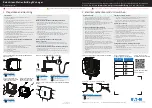
98
- Make regular stops to loosen up your
limbs and refresh yourself, and avoid
driving for hours on end.
- Keep a constant air circulation in the
passenger compartment.
- Never coast downhill with the engine
off: in these conditions the engine brake,
servo brake and power steering are
inefficient, braking requires greater
pressure on the pedal and steering will
be harder.
Driving at night
When you are travelling at night, follow
these fundamental rules:
- Reduce speed, particularly on dark
roads.
- Driving conditions are more demanding
at night, so take particular care.
- If you start feeling tired or sleepy, stop
immediately: to continue driving would
be a risk for yourself and for others.
Continue only after you have had a rest.
- At night, it is difficult to evaluate the
speed of the vehicles by seeing their
lights only: keep at a greater safety
distance than you would during the day.
- Use the high beams only outside of
urban areas and when you are sure that
they will not disturb other drivers.
- Turn off the high beams when you see
oncoming vehicles and use the low
beams.
- Keep the lights and headlights clean.
- Watch out for animals crossing the road
when travelling outside urban areas.
Driving in the rain
Rain and wet roads can cause hazardous
situations.
All manoeuvres are more difficult on a
wet road, as the tyres have significantly
less grip on the road. This means that the
braking distances increase considerably
and road-holding decreases.
Below is some advice for driving in the
rain:
- Keep a greater safety distance between
yourself and the other vehicles and
reduce your speed.
- When it is raining very hard, visibility is
also reduced. In these cases, to make
yourself more visible to others, turn on
the low beams even during the day.
- Do not drive through puddles at high
speeds as you do not know how deep
they may be. Travelling through a
puddle at high speed can result in losing
control of the vehicle (“aquaplaning”):
hold the steering wheel firmly.
WARNING
WARNING
If the road is wet, reduce your speed
to avoid “aquaplaning” phenomena,
during which the tyre no longer
touches the road surface. This is due
to the fact that, when the road is
very wet and the vehicle speed is
high, the side channels of the tyre
tread, because of their particular
shape or insufficient depth, are not
capable of removing all of the water
channelled, so that a layer of water
exists between the road surface and
the tyre. The fluid pressure
generated is so high as to support
the vehicle’s weight, making it
impossible for the driver to control
the vehicle.
- Use the ventilation system to defog the
windscreen (see page 107) and to avoid
visibility problems.
- Periodically check the condition of the
windscreen wiper blades.
Содержание 599 GTB FIORANO
Страница 1: ...OWNER S MANUAL ...
Страница 20: ...20 V Chassis number plate ...
Страница 48: ...48 Overview of controls ...
Страница 51: ...51 About your vehicle 2 1 3 8 7 6 5 4 Ref Control Page 27 Mechanical gearshift lever 92 ...
Страница 155: ...Warning notes ...
Страница 181: ...Glossary ...
Страница 182: ...182 ...
Страница 185: ...Table of Contents ...
















































